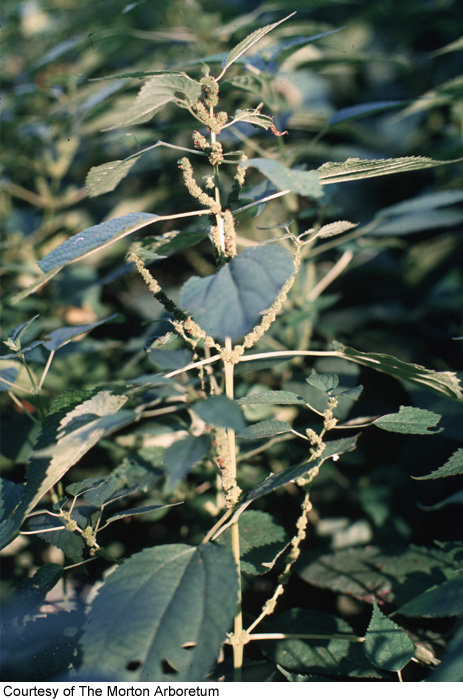|
Family: Urticaceae |
Herbs, subshrubs, or shrubs , perennial, rhizomatous, without stinging hairs, sparsely to ± densely pubescent or tomentose with hooked, curved, or straight, nonstinging hairs on all parts of plant. Stems simple to freely branched, erect. Leaves opposite or nearly opposite, or alternate; stipules present. Leaf blades lanceolate to broadly ovate, base rounded to cordate, less often cuneate, margins dentate or serrate, apex acuminate; cystoliths rounded. Inflorescences axillary, spikelike or paniculate. Flowers unisexual, staminate and pistillate flowers on same plant, rarely on different plants, in remote or crowded clusters in same or separate inflorescence; bracts linear. Staminate flowers: tepals 4; stamens 4; pistillode globose. Pistillate flowers: tepals 4, connate, adnate to ovary; staminodes absent; style persistent, elongate; stigma linear, straight or hooked. Achenes sessile, laterally compressed, ovoid, nearly orbicular, or ellipsoid, tightly enclosed by persistent perianth. x = 14. PLANT: Erect, monoecious, rarely dioecious, perennial, rhizomatous herbs, subshrubs, or shrubs without stinging hairs, sparsely to more or less densely hairy. LEAVES: opposite or occasionally subopposite or alternate, stipulate; blades lanceolate to widely ovate, dentate or serrate, the upper surface with punctiform cystoliths. INFLORESCENCE: axillary, of remote or crowded clusters of flowers borne along a central axis in a spike like arrangement, or paniculiform. STAMINATE FLOWERS: with 4 tepals, 4 stamens, the rudimentary pistil represented by a globose structure. PISTILLATE FLOWERS: with the perianth parts fused and adnate to the ovary; style elongate, persistent; stigma linear, straight, or hooked. FRUITS: flattened achenes NOTES: 2 spp. in N. Amer., ca. 100 worldwide, mostly in the tropics and subtropics. (For G. R. Boehmer). REFERENCES: Boufford, David E. 1992. Urticaceae. Ariz.-Nev. Acad. Sci. 26(1)2. Monoecious or dioecious; male fls minute, with 4-parted cal and 4 stamens; female fls with tubular, flattened to ovoid cal minutely 2-4-toothed at the summit; ovary enclosed by the cal; style filiform, exsert; fr an achene surrounded by the accrescent cal, the latter narrowly 2 winged; style persistent; herbs, shrubs, or small trees with opposite or alternate lvs and axillary infls. 100, warm reg. Gleason, Henry A. & Cronquist, Arthur J. 1991. Manual of vascular plants of northeastern United States and adjacent Canada. lxxv + 910 pp. ©The New York Botanical Garden. All rights reserved. Used by permission. |


